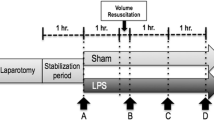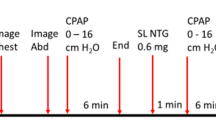Abstract
Objective
To assess global and splanchnic blood flow and oxygen transport in patients with sepsis with and without norepinephrine treatment.
Design
Prospective, clinical study.
Setting
University hospital intensive care unit.
Patients
A convenience sample of 15 septic shock patients treated with norepinephrine and 13 patients with severe sepsis who did not receive norepinephrine.
Measurements and main results
There were no differences between the two groups in global haemodynamics and oxygen transport. Splanchnic blood flow and oxygen delivery (splanchnic DO2 303±43 ml/min per m2) and consumption (splanchnic VO2 100±13 ml/min per m2) were much higher in the septic shock group compared with the severe sepsis group (splanchnic DO2 175±19 ml/min per m2, splanchnic VO2 61±6 ml/min per m2). Gastric mucosal pH was subnormal in both groups (septic shock 7.29±0.02, severe sepsis 7.25±0.02) with no significant difference. No significant differences between groups were detected in lactate values.
Conclusion
These data confirm a redistribution of blood flow to the splanchnic region in sepsis that is even more pronounced in patients with septic shock requiring norepinephrine. However, subnormal gastric mucosal pH suggested inadequate oxygenation in part of the splanchnic region due to factors other than splanchnic hypoperfusion. Progress in this area will depend on techniques that address not only total splanchnic blood flow, but also inter-organ flow distribution, intra-organ distribution, and other microcirculatory or metabolic malfunctions.
Similar content being viewed by others
References
Deitch EA, Berg R, Specian R (1987) Endotoxin promotes the translocation of bacteria from the gut. Arch Surg 122:185–190
Marshall JC, Christou NV, Horn R Meakins JL (1988) The microbiology of multiple organ failure: the proximal GI tract as an occult reservoir of pathogens. Arch Surg 123:309–315
Meakins JL, Marshall JC (1989) The gut as the motor of multiple system organ failure. In: Marston A, Bulkley GB, Fiddian Green RG, Haglund R 6 (eds). Splanchnic ischemia and multiple organ failure. Mosby, St. Louis, pp 339–348
Fong Y, Marano MA, Moldawer LL, Wei H, Calvano SE, Kenney JS, Allison AC, Cerami A, Shires GT, Lowry SF (1990) The acute splanchnic and peripheral tissue metabolic response to endotoxin in humans. J Clin Invest 85:1896–1904
Ruokonen E, Takala J, Kari A, Saxén H, Mertsola J, Hansen E (1993) Regional blood flow and oxygen transport in septic shock. Crit Care Med 21:1296–1303
Giraud GD, MacCannell KL (1984) Decreased nutrient blood flow during dopamine-and epinephrine-induced intestinal vasodilatation. J Pharm Exp Ther 230:214–220
Nelson DP, Samsel RW, Wood LD, Schumacker PT (1988) Pathologic supply dependence of systemic and intestinal O2 uptake during endotoxemia. J Appl Physiol 64:2410–2419
Pawlik W, Shepherd AP, Jacobson ED (1975) Effects of vasoactive agents on intestinal oxygen consumption and blood flow in dogs. J Clin Invest 56:484–490
Pawlik WW, Shepherd AP, Mailman D, Shanbour LL, Jacobson ED (1976) Effects of dopamine and epinephrine on intestinal blood flow and oxygen uptake. In: Grote J, Reneau D, Thews G (eds). Oxygen transport to the tissue-II. Plenum, New York London, pp 511–516
Richardson PDI, Granger DN, Kvietys PR (1980) Effects of norepinephrine, vasopressin, isoproterenol, and histamine on blood flow, oxygen uptake, and capillary filtration coefficient in the colon of the anesthetized dog. Gastroenterology 78:1537–1544
Shepherd AP, Mailman D, Burks TF, Granger HJ (1973) Effects of norepinephrine and sympathetic stimulation on extraction of oxygen and86Rb in perfused canine small bowel. Circ Res 33:166–174
Shepherd AP, Pawlik W, Mailman D, Burks TF, Jacobson ED (1976) Effects of vasoconstrictors on intestinal vascular resistance and oxygen extraction. Am J Physiol 230:298–303
Gutierrez G, Palizas F, Doglio G, Wainsztein N, Gallesio A, Pacin J, Dubin A, Schiavi E, Jorge M, Pusajo J, Klein F, San Roman E, Dorfman B, Shottlender J, Giniger R (1992) Gastric intramucosal pH as a therapeutic index of tissue oxygenation in critically ill patients. Lancet 339:195–199
Smithies M, Yee TH, Jackson L, Beale R, Bihari D (1994) Protecting the gut and the liver in the critically ill: effects of dobutamine. Crit Care Med 22:789–795
Silverman HJ, Tuma P (1992) Gastric tomometry in patients with sepsis. Effects of dobutamine infusions and packed red blood cell transfusions. Chest 102:184–188
Members of the American College of Chest Physicians/Society of Critical Care Medicine Consensus Conference Committee (1992) Definitions for sepsis and organ failure and guidelines for the use of innovative therapies in sepsis. Crit Care Med 20:864–874
Caesar J, Shaldon S, Chiandussi L, Guevara L, Sherlock S (1961) The use of indocyanine green in the measurement of hepatic blood flow and as a test of hepatic function. Clin Sci 21:43–57
Gottlieb ME, Strarron HH, Newell JC, Shah DM (1984) Indocyanine green: its use as an early indicator of hepatic dysfunction following injury in man. Arch Surg 119:264–268
Wahren J (1994) Splanchnic fractional extraction of different indocyanine green dye preparations in humans (abstract). Clinical Intensive Care 5 [Suppl]:47
Imamura M, Clowes GHA (1975) Hepatic blood flow and oxygen consumption in starvation, sepsis and septic shock. J Am Coll Surg 141:27–34
Norton L, Moore G, Eiseman B (1975) Liver failure in the postoperative patient: the role of sepsis and immunologic deficiency. Surgery 78:6–13
Dahn MS, Lange P, Lobdell K, Hans B, Jacobs LA, Mitchell RA (1987) Splanchnic and total body oxygen consumption differences in septic and injured patients. Surgery 101:69–80
Steffes CP, Dahn MS, Lange MP (1994) Oxygen transport-dependent splanchnic metabolism in the sepsis syndrome. Arch Surg 129:46–52
Fink MP (1993) Adequacy of gut oxygenation in endotoxemia and sepsis. Crit Care Med 21 [Suppl]:4–8
VanderMeer TJ, Wang H, Fink MP (1995) Endotoxemia causes ileal mucosal acidosis in the absence of mucosal hypoxia in a normodynamic porcine model of septic shock. Crit Care Med 23:1217–1226
Uusaro A, Ruokonen E, Takala J (1995) Gastric mucosal pH does not reflect changes in splanchnic blood flow after cardiac surgery. Br J Anaesth 74:149–154
Lang CH, Bagby GJ, Ferguson JL, Spitzer JJ (1984) Cardiac output and redistribution of organ blood flow in hypermetabolic sepsis. Am J Physiol 246R:331–337
Gutierrez G (1991) Cellular energy metabolism during hypoxia. Crit Care Med 19:619–626
Cain SM, Curtis S (1991) Experimental models of pathologic oxygen supply dependency. Crit Care Med 19:603–612
Hotchkiss RS, Karl IE (1992) Reevaluation of the role of cellular hypoxia and bioenergenic failure in sepsis. JAMA 267:1503–1510
Vallet B, Lund N, Curtis SE, Kelly D, Cain SM (1994) Gut and muscle tissue PO2 in endotoxemic dogs during shock and resuscitation. J Appl Physiol 76:793–800
Johnson GA, McNamara JJ (1981) Organ ischemia after hemorrhagic shock. Surg Forum 32:24–26
Knisely MH, Harding F, Debacker H (1957) Hepatic sphincters. Science 125:1023–1026
Leevy CM, George W, Lesko W, Deysine M, Abbott CC, Halligan EJ (1961) Observations on hepatic oxygen metabolism in man. JAMA 178:565–567
Breslow MJ, Miller CF, Parker SD, Walman AT, Traystman RJ (1987) Effect of vasopressors on organ blood flow during endotoxin shock in pigs. Am J Physiol 252H:291–300
Marik PE, Mohedin M (1994) The contrasting effects of dopamine and norepinephrine on systemic and splanchnic oxygen ultilization in hyperdynamic sepsis. JAMA 272:1354–1357
Author information
Authors and Affiliations
Rights and permissions
About this article
Cite this article
Meier-Hellmann, A., Specht, M., Hannemann, L. et al. Splanchnic blood flow is greater in septic shock treated with norepinephrine than in severe sepsis. Intensive Care Med 22, 1354–1359 (1996). https://doi.org/10.1007/BF01709551
Received:
Accepted:
Issue Date:
DOI: https://doi.org/10.1007/BF01709551




